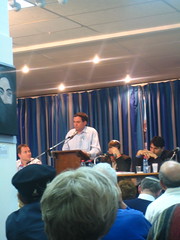With a great deal of fascination I watched, and lightly participated in, a Twitter-driven debate between many of the mayoral candidates in Calgary. The event, called Twibate Tuesday, brought together most of the candidates into a virtual room (Twitter) where roughly every ten minutes a new question was asked by the moderator, Calgary Politics. I love the concept as it provided potential for citizen interaction.
Twitter is often compared to a cocktail party; loud, noisy, plenty of side conversations…. The debate was much the same. Great questions were asked by the moderator, and by the participants, and by the crowd, but it was easy to get lost.
So, how could this be made better? Here are a few thoughts, let me know what you think:
- Crowdsource the Twibate questions ahead of the debate. Through platforms like Bubbleideas (yes, I do sell this solution) you can bring all interested parties together to generate the right questions.
- Moderators can either pre-define questions or accept idea questions from citizens.
- Citizens vote and comment on questions, enabling those running the debate to pick the questions people most care about.
- Use a Facebook page for the debate. Keeping the debate between the debaters is critical. Too often it was unclear which questions were being answered and unclear if every candidate answered each question.
- Use Twitter as the debate back channel. Citizens should be free to comment and interact with the moderator and candidates throughout the debate. However, it is important that this interaction does not confuse citizens reading the responses.
When the debate is completed the entire Twitter stream should be posted to the Facebook page. Citizens who missed the debate would be able to view both streams to get a complete view, one clean and crisp, one with all the noise of the cocktail party.
How would you approach a debate using new media options? Would you use other approaches?
John





Leave a Reply
You must be logged in to post a comment.